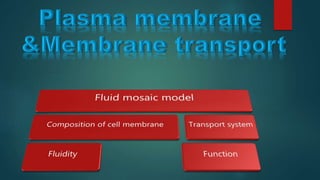Plasma membrane and membrane transport
•Als PPTX, PDF herunterladen•
0 gefällt mir•83 views
in this slides we are talking about fluid mosaic model transport active passive diffusion and bilayer
Melden
Teilen
Melden
Teilen

Empfohlen
Empfohlen
Weitere ähnliche Inhalte
Was ist angesagt?
Was ist angesagt? (20)
Ähnlich wie Plasma membrane and membrane transport
Ähnlich wie Plasma membrane and membrane transport (20)
Mehr von vidan biology
Mehr von vidan biology (20)
Vernalization (Revernalization, Devernalization) gene

Vernalization (Revernalization, Devernalization) gene
Innate Behavior (Animal Behavior) Taxis, Fixed Action Pattern, reflex.

Innate Behavior (Animal Behavior) Taxis, Fixed Action Pattern, reflex.
Fish migration (Animal Behavior) Catadromous, Anadromous

Fish migration (Animal Behavior) Catadromous, Anadromous
Kürzlich hochgeladen
Making communications land - Are they received and understood as intended? webinar
Thursday 2 May 2024
A joint webinar created by the APM Enabling Change and APM People Interest Networks, this is the third of our three part series on Making Communications Land.
presented by
Ian Cribbes, Director, IMC&T Ltd
@cribbesheet
The link to the write up page and resources of this webinar:
https://www.apm.org.uk/news/making-communications-land-are-they-received-and-understood-as-intended-webinar/
Content description:
How do we ensure that what we have communicated was received and understood as we intended and how do we course correct if it has not.Making communications land - Are they received and understood as intended? we...

Making communications land - Are they received and understood as intended? we...Association for Project Management
Kürzlich hochgeladen (20)
Mixin Classes in Odoo 17 How to Extend Models Using Mixin Classes

Mixin Classes in Odoo 17 How to Extend Models Using Mixin Classes
ICT Role in 21st Century Education & its Challenges.pptx

ICT Role in 21st Century Education & its Challenges.pptx
Python Notes for mca i year students osmania university.docx

Python Notes for mca i year students osmania university.docx
Making communications land - Are they received and understood as intended? we...

Making communications land - Are they received and understood as intended? we...
Food safety_Challenges food safety laboratories_.pdf

Food safety_Challenges food safety laboratories_.pdf
This PowerPoint helps students to consider the concept of infinity.

This PowerPoint helps students to consider the concept of infinity.
Unit-IV; Professional Sales Representative (PSR).pptx

Unit-IV; Professional Sales Representative (PSR).pptx
Russian Escort Service in Delhi 11k Hotel Foreigner Russian Call Girls in Delhi

Russian Escort Service in Delhi 11k Hotel Foreigner Russian Call Girls in Delhi
Kodo Millet PPT made by Ghanshyam bairwa college of Agriculture kumher bhara...

Kodo Millet PPT made by Ghanshyam bairwa college of Agriculture kumher bhara...
UGC NET Paper 1 Mathematical Reasoning & Aptitude.pdf

UGC NET Paper 1 Mathematical Reasoning & Aptitude.pdf
Plasma membrane and membrane transport
- 2. COMPOSITION OF CELL MEMBRANE 1. Lipids I. Phosopholipids II. Sterols 2. Proteins i. Integral ii. Peripheral 3. Carbohydrates i. Glycolipids ii. Glycoproteins Globuler protein CarbohydrateGlycoprotein Glyco lipid Integral protein Channel Protein Cholestrol Peripheral protein
- 3. Phospholipids There are two important parts of a phospholipid: the head and the two tails. The head is a phosphate molecule that is attracted to water (hydrophilic). The two tails are made up of fatty acids (chains of carbon atoms) that aren’t compatible with, or repel, water (hydrophobic). The cell membrane is exposed to water mixed with electrolytes and other materials on the outside and the inside of the cell. When cellular membranes form, phospholipids assemble into two layers because of these hydrophilic and hydrophobic properties. The phosphate heads in each layer face the aqueous or watery environment on either side, and the tails hide away from the water between the layers of heads, because they are hydrophobic Cholesterol Cholesterol is a type of steroid which is helpful in regulating molecules entering and exiting the cell. The cholesterol molecules are randomly distributed across the phospholipid bilayer, helping the bilayer stay fluid in different environmental conditions. The cholesterol holds the phospholipids together so that they don’t separate too far, letting unwanted substances in, or compact too tightly, restricting movement across the membrane. Without cholesterol, the phospholipids in your cells will start to get closer together when exposed to cold, making it more difficult for small molecules, like gases to squeeze in between the phospholipids like they normally do. Without cholesterol, the phospholipids start to separate from each other, leaving large gaps. Hydrophilic head Hydrophobic Tail
- 4. 3) Proteins The cell is made up of two different types, or “classes”, of proteins. Integral proteins are nestled into the phospholipid bilayer and stick out on either end. Integral proteins are helpful for transporting larger molecules, like glucose, across the cell membrane. They have regions, called “polar” and “nonpolar” regions, that correspond with the polarity of the phospholipid bilayer.
- 5. Transport through cell membrane Classification based on function Membrane transport Passive transport Active transport Simple diffusion Facilitated Via Ion channels Via various transporters
- 6. Different types of transport
- 8. Facilitated diffusion • Carrier mediated and involves transporter protein. • A transporter protein reduces the ∆G€ for transmembrane diffusion of the solute. • It does this by forming noncovalent interactions with the dehydrated solute to replace the H-bonding with water and by providing hydrophilic transmembrane passageway. • Example – Glucose transporters.
- 9. Endocytosis, exocytosis and membrane fluidity •Large molecules, such as neurotransmitters and hormones, are transported into and out of the cell in fluid- filled sacs called vesicles. •Endocytosis is the intake of extracellular material through vesicles. Endocytotic vesicles are formed when the plasma membrane is pulled inwards, enclosing a bit of extracellular material. The materials are transported within the vesicle to different locations in the cell. •Exocytosis is the removal of cell products through vesicles. These vesicles originated at different locations and travel to the plasma membrane, where they fuse to release contents. •Both endo- and exocytosis require energy in the form of ATP, so they can be considered forms of active transport. •The fluidity and dynamic properties of the plasma membrane mean that vesicles can form and reform indefinitely. Flip-Flop movement is restricted and is catalysed by an enzyme “Flippase”- important during membrane lipid synthesis
